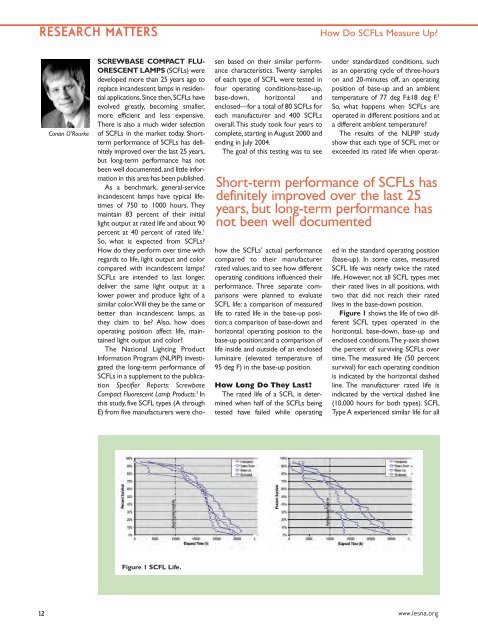P R O G R E S S R E P O R T - Illuminating Engineering Society
P R O G R E S S R E P O R T - Illuminating Engineering Society
P R O G R E S S R E P O R T - Illuminating Engineering Society
You also want an ePaper? Increase the reach of your titles
YUMPU automatically turns print PDFs into web optimized ePapers that Google loves.
RESEARCH MATTERS<br />
How Do SCFLs Measure Up?<br />
Conan O’Rourke<br />
SCREWBASE COMPACT FLU-<br />
ORESCENT LAMPS (SCFLs) were<br />
developed more than 25 years ago to<br />
replace incandescent lamps in residential<br />
applications.Since then,SCFLs have<br />
evolved greatly, becoming smaller,<br />
more efficient and less expensive.<br />
There is also a much wider selection<br />
of SCFLs in the market today. Shortterm<br />
performance of SCFLs has definitely<br />
improved over the last 25 years,<br />
but long-term performance has not<br />
been well documented, and little information<br />
in this area has been published.<br />
As a benchmark, general-service<br />
incandescent lamps have typical lifetimes<br />
of 750 to 1000 hours. They<br />
maintain 83 percent of their initial<br />
light output at rated life and about 90<br />
percent at 40 percent of rated life. 1<br />
So, what is expected from SCFLs?<br />
How do they perform over time with<br />
regards to life, light output and color<br />
compared with incandescent lamps?<br />
SCFLs are intended to last longer,<br />
deliver the same light output at a<br />
lower power and produce light of a<br />
similar color.Will they be the same or<br />
better than incandescent lamps, as<br />
they claim to be? Also, how does<br />
operating position affect life, maintained<br />
light output and color?<br />
The National Lighting Product<br />
Information Program (NLPIP) investigated<br />
the long-term performance of<br />
SCFLs in a supplement to the publication<br />
Specifier Reports: Screwbase<br />
Compact Fluorescent Lamp Products. 2 In<br />
this study, five SCFL types (A through<br />
E) from five manufacturers were chosen<br />
based on their similar performance<br />
characteristics. Twenty samples<br />
of each type of SCFL were tested in<br />
four operating conditions-base-up,<br />
base-down, horizontal and<br />
enclosed—for a total of 80 SCFLs for<br />
each manufacturer and 400 SCFLs<br />
overall.This study took four years to<br />
complete, starting in August 2000 and<br />
ending in July 2004.<br />
The goal of this testing was to see<br />
how the SCFLs’ actual performance<br />
compared to their manufacturer<br />
rated values, and to see how different<br />
operating conditions influenced their<br />
performance. Three separate comparisons<br />
were planned to evaluate<br />
SCFL life: a comparison of measured<br />
life to rated life in the base-up position;<br />
a comparison of base-down and<br />
horizontal operating position to the<br />
base-up position; and a comparison of<br />
life inside and outside of an enclosed<br />
luminaire (elevated temperature of<br />
95 deg F) in the base-up position.<br />
How Long Do They Last?<br />
The rated life of a SCFL is determined<br />
when half of the SCFLs being<br />
tested have failed while operating<br />
Short-term performance of SCFLs has<br />
definitely improved over the last 25<br />
years, but long-term performance has<br />
not been well documented<br />
under standardized conditions, such<br />
as an operating cycle of three-hours<br />
on and 20-minutes off, an operating<br />
position of base-up and an ambient<br />
temperature of 77 deg F±18 deg F. 3<br />
So, what happens when SCFLs are<br />
operated in different positions and at<br />
a different ambient temperature?<br />
The results of the NLPIP study<br />
show that each type of SCFL met or<br />
exceeded its rated life when operated<br />
in the standard operating position<br />
(base-up). In some cases, measured<br />
SCFL life was nearly twice the rated<br />
life. However, not all SCFL types met<br />
their rated lives in all positions, with<br />
two that did not reach their rated<br />
lives in the base-down position.<br />
Figure 1 shows the life of two different<br />
SCFL types operated in the<br />
horizontal, base-down, base-up and<br />
enclosed conditions.The y-axis shows<br />
the percent of surviving SCFLs over<br />
time. The measured life (50 percent<br />
survival) for each operating condition<br />
is indicated by the horizontal dashed<br />
line. The manufacturer rated life is<br />
indicated by the vertical dashed line<br />
(10,000 hours for both types). SCFL<br />
Type A experienced similar life for all<br />
Figure 1 SCFL Life.<br />
12 www.iesna.org

















